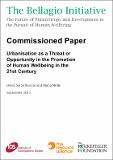| dc.contributor.author | Satterthwaite, David | |
| dc.contributor.author | Mitlin, Diana | |
| dc.date.accessioned | 2014-04-02T14:35:44Z | |
| dc.date.available | 2014-04-02T14:35:44Z | |
| dc.date.issued | 2012 | |
| dc.identifier.citation | Mitlin, D. Satterthwaite, D (2012) 'Urbanisation as a Threat or Opportunity' The Bellagio Iniative, Brighton: IDS | en_GB |
| dc.identifier.uri | https://opendocs.ids.ac.uk/opendocs/handle/20.500.12413/3719 | |
| dc.description.abstract | Urbanisation is often seen as a problem for development yet all the world’s wealthiest nations are predominantly urban and almost all urbanisation among low- and middle-income nations is associated with economic growth. The world’s largest cities are heavily concentrated in the world’s largest economies. The more urbanised nations in Africa, Asia and Latin America generally have the highest life expectancies and lowest infant and child mortality rates. The nations with the worst health and living conditions among their urban populations are generally the least urbanised. Urbanisation is often seen as the main driver of ecological damage and human-induced climate change. But among the world’s wealthiest cities with the highest living standards, per capita greenhouse gas emissions vary by a factor of ten or more. There are cities and city districts that show how urban concentration can delink a high quality of life from unsustainable levels of consumption and the ecological damage and greenhouse gas emissions these cause. Several key issues are raised by an increasingly urbanised world. | en_GB |
| dc.description.sponsorship | The Rockerfeller Foundation | en_GB |
| dc.language.iso | en | en_GB |
| dc.publisher | IDS | en_GB |
| dc.rights.uri | http://www.ids.ac.uk/files/dmfile/IDSOpenDocsStandardTermsOfUse.pdf | en_GB |
| dc.subject | Aid | en_GB |
| dc.subject | Rural Development | en_GB |
| dc.title | Urbanisation as a Threat or Opportunity | en_GB |
| dc.type | Series paper (non-IDS) | en_GB |


